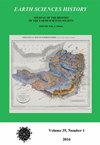意大利地质学家斯奇皮奥内-布赖斯拉克(Scipione Breislak)的《地质学入门》(1811 年)中的地球理论和 "柱状构造 "理论
IF 0.6
4区 哲学
Q4 GEOSCIENCES, MULTIDISCIPLINARY
引用次数: 0
摘要
Scipione Breislak 可被视为十八世纪末十九世纪初意大利最著名的 "冥王星学家 "之一。17 世纪 90 年代,他在那不勒斯的农齐阿泰拉军事学院担任物理学教授,同时还致力于研究维苏威火山和菲勒格拉埃火山。因此,他熟悉了火山现象。布赖斯拉克关于坎帕尼亚(意大利南部)火山田的著作揭示了托尔伯恩-奥洛夫-伯格曼的理论和安托万-洛朗-德-拉瓦锡的化学如何影响了他对火山爆发是由石油沉积点燃引发的这一观点的信念。由于罗马共和国的垮台,布赖斯拉克自愿流亡法国,之后返回意大利,定居米兰,并于 1802 年被任命为火药督察。由于新的行政职务,他有机会继续研究矿物学和地质学,主要侧重于伦巴第和阿尔卑斯山的地层学。在 "米兰时期",他出版了《地质学导论》(Introduzione alla geologia,1811 年),该书可被视为意大利第一本关于 "新 "地质学的手册。在这本专著中,他还借鉴了赫顿的观点,描述了结晶岩的岩石地层学特征。在不忽视布雷兹拉克火山学假说的前提下,本文旨在分析十九世纪冥王星(赫顿)地质学理论对他在《地质学入门》中描绘的地球历史的影响。从 Breislak 对过渡岩的否定中也可以看出普鲁顿主义的影响--普鲁顿主义是理查德-柯万(Richard Kirwan)用来定义詹姆斯-赫顿地质学体系的术语。事实上,他认为事实上,他认为:"大自然并不制造通道或过渡,它的每一种产物都有其特定和特殊的存在方式"(布雷斯拉克,1811 年,第 1 卷,第 308-309 页)。本文章由计算机程序翻译,如有差异,请以英文原文为准。
THEORIES OF THE EARTH AND ‘PLUTONISM’ IN THE INTRODUZIONE ALLA GEOLOGIA BY THE ITALIAN GEOLOGIST SCIPIONE BREISLAK (1811)
Scipione Breislak may be considered as one of the most renowned Italian ‘Plutonists’ at the end of the eighteenth and beginning of the nineteenth centuries. In the 1790s, he was a professor of Physics at the Military Academy of Nunziatella in Naples, where he also devoted himself to the study of Vesuvius and the Phlegraean Fields. Thus, he acquainted himself with volcanic phenomena. Breislak's works about the volcanic fields of Campania (Southern Italy) disclosed how Torbern Olof Bergman's theories and Antoine-Laurent de Lavoisier's chemistry had affected his belief in the idea that volcanic eruptions were triggered by ignition of petroleum deposits. After a voluntary exile in France, owing to the downfall of the Roman Republic, Breislak returned to Italy and settled in Milan, where he was appointed as an Inspector of Gunpowder in 1802. Due to his new administrative duties, he had the opportunity to continue studying mineralogy and geology, focusing primarily on the stratigraphy of Lombardy and of the Alps. During the ‘Milanese period’, he published the Introduzione alla geologia (Introduction to geology, 1811), which may be regarded as the first Italian handbook about the ‘new’ science of Geology. In the monograph, he also drew on Huttonian ideas in order to describe the lithostratigraphic features of crystalline rocks. Without neglecting Breislak's volcanological hypotheses, this paper aims to analyze the influence that nineteenth-century Plutonist (Huttonian) geological theories had on the Earth's history that he depicted in the Introduzione alla geologia. The influence of Plutonism—a term that Richard Kirwan introduced to define James Hutton's geological system—may also be recognized in Breislak's rejection of transition rocks. Indeed, according to him: “nature does not make passages or transitions, and each of its products has a specific and particular way to exist” (Breislak 1811, volume 1, pp. 308–309).
求助全文
通过发布文献求助,成功后即可免费获取论文全文。
去求助
来源期刊

Earth Sciences History
GEOSCIENCES, MULTIDISCIPLINARY-HISTORY & PHILOSOPHY OF SCIENCE
CiteScore
1.00
自引率
0.00%
发文量
1
审稿时长
>12 weeks
期刊介绍:
Earth Sciences History promotes and publishes historical work on all areas of the earth sciences – including geology, geography, geophysics, oceanography, paleontology, meteorology, and climatology.
The journal honors and encourages a variety of approaches to historical study: biography, history of ideas, social history, and histories of institutions, organizations, and techniques.
Articles are peer reviewed.
 求助内容:
求助内容: 应助结果提醒方式:
应助结果提醒方式:


